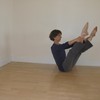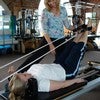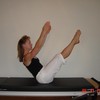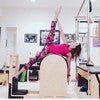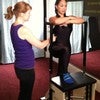Description
About This Video
Transcript
Read Full Transcript
Hi, I'm Ruth Alpert and I'm here today to talk about one particular issue, which I tend to see a fair amount. And the issue is basically we have set size for equipment, right? We have one size reformer, usually one may be two sizes of boxes, but we have bodies and lots of different sizes and not only different sizes but different proportions. If some of you know Michelle Larson, who is my teacher, Michelle and I have the same length arms, but she's almost six feet and I'm barely five, two and a half. So I have very short legs and very long arms. Other people have short arms and long legs and other people are just big for the equipment. And if you put a child on the equipment, you have other issues of the equipment being too big. So there are ways in which I've figured out to amend or, or, um, work with that situation so that everybody's body can be in the ideal anatomical position to get the muscles that we're trying to get to work, to work, to be efficient in muscle use so that we're not fighting our own structure.
And very often things show up in the shoulders and that's what gets created. So the basic idea I'm going to demonstrate on my little milking stool because my legs are so short, I have to have this tiny little school to make my knees go too high. And besides which there's a hidden secret in polarities which nobody ever talks about and that's that Joe PyLadies believed in milking cows and you get a lot of exercise in your arms from milking cows. So here's my little milking stool and I'm sitting here and I don't know if you can see it, but it's forcing my back, my pelvis into a curl for me to sit. In fact, it's actually bringing me into a fetal position, right? For me to go into fetal is very easy from here.
And one of the things about the fetal position is the arms are coming in and this is an exaggeration, but this is what the nervous system is being told. The minute the pelvis, the tail curls under and the pelvis starts to roll the nerves. This nervous system gives the spine the message that we're going this way. But then we're asking people to do our homework. Well, I'm stuck. Of course it's gonna go into my shoulders for me to then, so one correction we give our clients is drop your shoulders, but if their spines are already starting a curl, even if it's very subtle, it's going to interfere the shoulder work.
One of the things that we also tell our clients is to sit up straight [inaudible] and I do plots, so I have the capacity to sit up straight, right? But what doesn't show, and you wouldn't see necessarily as a teacher, is the amount of stress that goes into my hip flexors to sit up straight on my sits bones in this position. It puts a strain on my back and a strain in here, even though it might look good from the outside. So that's the basic premise of what we're going to be talking about today. And we're going to look at it on a few different bodies and in a few different ways. So I'm going to take the stool off and I'm going to pull up to people and we're going to demonstrate this in another kind of way.
So Amanda and Teresa come on up. So the first thing we're going to do is a particular exercise that I learned in my Alexander Technique teacher training, and they're going to be great demos for it. So the first thing you're going to do is round over. You can bend your knees or straightening or keep your knees straight, that doesn't matter, but keep your back really rounded and right from there. Lift your arms and notice how far you can go and what it feels like.
And you all can see what it looks like. Okay. Drop your arms, come up and sit. Stand up straight. So the next one is going to be a flat back. You can bend your knees and go over with your back, totally flat. Stick your butt out and flatten your back, Amanda. Yeah, there you go. Bend your knees. Both of you.
Bend your knees so that your hip sockets relaxed and complete flat back. And now lift your arms from that position. And notice what it feels like and if it's any different. Good. And come up. Amanda's wearing the mic. So did that feel different to you? Yes, I was able to raise my arms up higher and less strain in my lower back. So the point is that as I was demonstrating on the stool, when your back is rounded, your scapula are protracted forward and then lifting your arms has a very limited range. Whereas once your spine is elongated, your scapula can slide down your back and you have much more range.
Thanks. Theresa will come up in a little while and Amanda's going to get on the box because this is the exercise where I often see the issue. Here's the Amanda's sitting on the box. You can see that our knees are higher than her sits bones. So even though she's strong enough to sit up straight, it's still sending a signal to the nervous system to go into spinal flection.
So, but go ahead and do it from here. And I have her on one spring. You know, it's just a basic tricep exercise, not a big deal. Good. That's plenty. Now I have these, uh, go ahead and come off the box.
And for machine etiquette, we always cover the box so that the vinyl doesn't have any sharp edges. I had these made and they're very handy for all kinds of things. But looking at Amanda, I actually think she's going to need more than one. I have to. So again, machine etiquette, we put a towel down and I had another one made up that smaller just for various reasons and now it's called the princess and the pea. Go ahead and sit on this and let's look and see. She could use even more.
So I have another tool. I'll be right back. Piece of Styrofoam, a yoga, a yoga from the yoga world, I believe. Let's try that. What I'm looking for is her knees level with her sits bones. Yes, that does the trick. So for you out there, when you're working with your clients, what you're looking for is the sitz bones and the knees at a right angle, not the knees higher up. Now pull the straps back.
Yes, I can go much further back more easily. So more comfortable, less strain in my back, my lower back. Now because of what she just said, less strain on her. Lower back, more comfortable, bigger range of motion. Now I can add weight and she can actually work the muscles we're looking for.
So stop for a moment. I'm going to add a blue. Uh, Yup. Um, so she's now on a red and blue. How does that feel? Very heavy, but good. It feels very targeted, right? It really does. Yeah. I can really feel my triceps. Right. And it's a tricep exercise. Yeah. So we don't want her lower back to be giving her more sensation than our triceps. I don't feel anything in my low back anymore. Yay. Yay. Okay. Thank you Amanda. All right, my pleasure.
So it's a simple thing, right? I mean with Amanda's case, it's a little pyramid that princess in the Pea, but it makes such a difference to get people in the right proportion for what you're trying to do. So we're going to look at this on another tall, big body. And I actually had trouble finding really tall, big bodies. And so Perry, will you come up and show this please? You all might know Perry from behind the camera plot anytime off audience. This is Perry who's always behind the camera, not in front of it. So we're going to look at it on Perry. Also sitting with your feet in the headrest just right.
And you can see right away how his knees being high is throwing his body backwards, right? And what as a teacher, what mostly what I would say is, oh, your back is too far back. Sit Up. Right? So then I'm manipulating and can you feel how tight that is there? It's just like, and then I'm going to ask you to do arm work, right? I pick my arguments. This is not one of them. So come on off and being as that you're even taller than Amanda.
We're gonna use the same, uh, the same pyramid set up. You know, if you have a cushion that you don't need three of these and you just have one big cushion, that's great, but you don't want it too squishy. Right? It has to be hard enough that they get feedback of where their bones are and they don't sink into it. So let's try it again and again, I'm looking for the relationship of sits bone to me. Good. And I'm going to leave it on a blue and a red for you cause you haul camera's around. So you're a big and strong and just pull back.
Just triceps. Look straight ahead.
How tall are you? Actually? Four. Six, four. I know you all have clients out there who are six, four and take it to heart. Maybe you need like a ladder. You need to put a ladder on the box for them or two boxes. How's that? Let's put two boxes down. Okay, so case in point. You get what I'm trying to say here. Thanks Perry.
Okay, so now we're going to look at it on a body that's more average sized. Um, my regular client Irene is going to come up and demo what for us. But before I ring guts on the box, I have to brag. Oh, I can't help it. I'm sorry. Irene is 87. She started with me when she was 84 having never exercise since she had four kids in three years. No twins, two kids in a set of twins in four years, three years, three years I, she is now doing an intermediate level workout and you should see her lights gorgeous. We, I'm just in awe of our rain. So I'm really, really grateful that you agreed to come and be a demo model today. So go ahead and sit on the box without any pads and Irene to her sits bones are lower than her knees, but not as dramatically as with Amanda and Perry.
So it's the kind of thing you probably wouldn't notice if you weren't looking for it. But the other thing I know about Irene is that she has a very tight uh, lumbar. Some, some of her lumbars are very tight and sitting up straight is can be an issue. So I actually, your knees are quite a bit higher than your sitz bones. So come on off. She might not need the whole pyramid.
We'll take the blue one off and start with the two white ones. So let's see if these are, do the trick. Yeah, that's better proportions. And Irene is a really good demo model for someone who's pretty much average height, but she has long legs, right? It's not her torso that's long. That's her leg length. And, and it shows up when she's sitting. So sitting on the box, we're looking for knee again, the sitz bones in the knees to be on the same latitude plane horizon latitude horizon. Well, no, I guess we have mountains out there that doesn't count. Okay.
So you know what I forgot to do. Let's take these off and have you do the pulling straps without, and let me lighten the weight again. So I'm, I took off the blue and she's on w uh, she's one red and Irene is very strong. So if this is too light, let me know and I'll add weight
Okay, so look straight ahead.
Can you describe the difference? Well, it's just that there no stress in my neck for one thing. And, and, and I don't, I'm not, I'm not lifting my shoulders up to try to get back either. And even if it's not really blatantly visible, do a couple more what you can sense. Just the sensing feeling of what it looks like when you watch it, that you don't feel tense in your own body watching and when. So when the person doing the exercise is doing it with a lot of tension, often you'll embody that tension. You'll pick it up without realizing it. So there's two I exhale, right? I have a sense of ease watching you and that's another really good gauge as a teacher. Thanks. Ooh, put them down. Good.
Come on off. I do want to say that I'm keeping this tutorial really, really simple with just this one exercise, but this is an issue that shows up everywhere. The sitting rowing series hug a tree salute. Anytime your client is sitting and their low back is compromised, use these pads. That's why I have a small one for when they're sitting on the, on the carriage itself. Um, it's just a really important issue that they're right up on the sitz bones themselves. Think they're the issial. Tuberocities is the formal name, um, and they're not sitting back on their tail. These are useful for sitting on the carriage, but even when the legs are straight again, you know, in that case you're not looking at Nita sitz phone relationship. At that point, I'm looking at six bone and tail relationship because if the pelvis is rolled towards the back of the sits bones, you're essentially sitting on your tail and I don't, the girls who've had really long hair can relate to this. The guys can't.
But if it's like you're sitting on your hair or you're sitting on the long tassel of a scarf and you go to get up and you can't really move because you're stuck, you know something like, or you're sitting on your shirt tail and you go to move and you're stuck, that's the issue that you want to be right up on those sitz bones, wherever that is in your body so that your tail, which is the southern most part of your spine is free because when you're on your sits bones, your tail is free floating. So then your whole spine is available to have its curves and you're not putting pressure on the southern end of your spine, which again is going to then compromise the thoracic curve, which affects the Scapula, which affects then the upper traps go into high gear and we get back to that inner body dialogue where the nervous system goes. She wants us to raise our arms, but she's putting us in a fetal position. And how are we gonna pull this off? So we're going to have to get the tropics, we're going to have to get the glutes to, we're going to have to get quads, quads you in on this one. Okay. Quad is coming. Pretty soon you have the entire body going into like, um, and the upper traps are the famous ones. They'll be like, okay, where's the trouble? Ready to fire the ballistic, you know, the missiles, right?
They'll, they'll tense no matter what. So ideally you get the sitz bones in the right position. The tail is free. Floating the spine is, is in its normal curves. With any luck if you don't have scoliosis. Um, and then the shoulders, the Scapula can move freely on the ribs and then you still have to deal with the traps because the traps are, you know, they're high-strung. They're just the high-strung folks. You know, you've got to always just stop drinking coffee and tell them to chill out.
So our next demo model is going to be Teresa, who just so happens to be Irene [inaudible] daughter who I also teach regularly. Theresa has a history of a herniated disc in her lower back. So say hello to the camera, Teresa. So we're going with Teresa. I'm going to show what we were just talking about. Um, when I mentioned that this is also useful when you're sitting right on the carriage, not necessarily necessarily just on a box. So Theresa, have a seat.
We're going to do exactly the same exercise. You're going to sit towards that end with your legs straight. Don't fall off the edge though. Another client. Um, so before you even start, look at the position. I'm looking right back here, right?
You can see how that saw already. She's already in a curled pelvis and now do the tricep. She's on one red spring. Just look straight ahead and pull up and notice what that feels like and notice what you see.
Go ahead and have a seat. Good. And slide a little more towards the front of the box. And now just sit up straight and pull in your abs and lift your head and come right up on your sits there. She can do that now. Right. And now take the straps and go ahead and pull back. Good. Look, it's a totally different picture.
And tell us what you feel, how it feels different. Well, it's really hard for me often to get off the back like this and this makes it a lot easier to do that. And then also I can just, um, focus on my arms, right. Which is what we want. Yeah. And her abs and her length and all the other things that we focus on in Palladia. So at the same time, which I didn't happen to mention to her, but she was doing okay. Anyway. So I think I've made my point. In fact, I think I've dug my point deep into the ground. We've overstated the problem, but, um, it is, uh, for me it's really a big issue. Um, and I often say that my job as a teacher is to make my job easier. And if I can get my client in the right tech in the right alignment, then I don't have to work so hard to get her shoulders to drop and to get the muscles to work correctly.
And so these are just little tidbits and tricks and things that I've learned over the years. Um, and I hope it's been helpful. Thanks.
Comments

Great video! I do also have people just move back a bit until the knees are level to the hips... wondering if that's a bad choice. But I always thought this even in the mat work when we 1/2 roll back instead of rolling like a ball! I always felt this was wrong for a lot of people. Glad to see the attention paid to every type of body.
You need to be a subscriber to post a comment.
Please Log In or Create an Account to start your free trial.
















